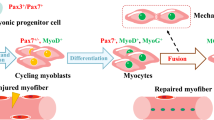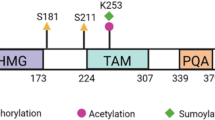Abstract
The muscle regulatory transcription factor MyoD is a master regulator of skeletal myoblast differentiation. We have previously reported that MyoD is also necessary for the elevated expression of the pro-apoptotic Bcl2 family member PUMA, and the ensuing apoptosis, that occurs in a subset of myoblasts induced to differentiate. Herein, we report the identification of a functional MyoD binding site within the extended PUMA promoter. In silico analysis of the murine PUMA extended promoter revealed three potential MyoD binding sites within 2 kb of the transcription start site. Expression from a luciferase reporter construct containing this 2 kb fragment was enhanced by activation of MyoD in both myoblasts and fibroblasts and diminished by silencing of MyoD in myoblasts. Experiments utilizing truncated versions of this promoter region revealed that the potential binding site at position − 857 was necessary for expression. Chromatin immunoprecipitation (ChIP) analysis confirmed binding of MyoD to the DNA region encompassing position − 857. The increase in MyoD binding to the PUMA promoter as a consequence of culture in differentiation media (DM) was comparable to the increase in MyoD binding at the myogenin promoter and was diminished in myoblasts silenced for MyoD expression. Finally, ChIP analysis using an antibody specific for the transcription factor p53 demonstrated that, in myoblasts silenced for MyoD expression, p53 binding to the PUMA promoter was diminished in response to culture in DM. These data indicate that MyoD plays a direct role in regulating PUMA expression and reveal functional consequences of MyoD expression on p53 mediated transcription of PUMA.






Similar content being viewed by others
References
Ceafalan LC, Popescu BO, Hinescu ME (2014) Cellular players in muscle regeneration. Biomed Res Int. doi:10.1155/2014/957014
Ten Broek RW, Grefte S, Von den Hoff JW (2010) Regulatory factors and cell populations involved in skeletal muscle regeneration. J Cell Physiol 224(1):7–16
Partridge TA, Morgan JE (2014) Multiple insights from myogenic cell transplants. Hum Gene Ther 25(5):404–405
Grenier G, Rudnicki MA (2006) The potential use of myogenic stem cells in regenerative medicine. Handb Exp Pharmacol 174:299–317
Skuk D, Caron NJ, Goulet M, Roy B, Tremblay JP (2003) Resetting the problem of cell death following muscle-derived cell transplantation: detection, dynamics and mechanisms. J Neuropathol Exp Neurol 62:951–967
Skuk D, Tremblay JP (2014) Clarifying misconceptions about myoblast transplantation in myology. Mol Ther 22:897–898
Mercuri E, Muntoni F (2013) Muscular dystrophy: new challenges and review of the current clinical trials. Curr Opin Pediatr 25(6):701–707
Cheng CS, Davis BN, Madden L, Bursac N, Truskey GA (2014) Physiology and metabolism of tissue-engineered skeletal muscle. Exp Biol Med 239:1203–1214
Sandri MC, Massimino ML, Geromel V, Arslan P (1996) Myoblasts and myotubes in primary cultures deprived of growth factors undergo apoptosis. Basic Appl Myol 6:257–260
Miller JB, Stockdale FE (1986) Developmental regulation of the multiple myogenic cell lineages of the avian embryo. J Cell Biol 103:2197–2208
Dee K, Freer M, Mei Y, Weyman CM (2002) Apoptosis coincident with the differentiation of skeletal myoblasts is delayed by caspase 3 inhibition and abrogated by MEK-independent constitutive Ras signaling. Cell Death Differ 9:209–218
Wang J, Walsh K (1996) Resistance to apoptosis conferred by Cdk inhibitors during myocyte differentiation. Science 273:359–361
Sandi M, Carraro U (1999) Apoptosis of skeletal muscles during development and disease. Int J Biochem Cell Biol 12:1373–1390
Fernando P, Megeney LA (2006) Is caspase-dependent apoptosis only cell differentiation taken to the extreme? FASEB J 21(1):8–17
Shaltouki A, Freer M, Mei Y, Weyman CM (2007) Increased expression of the pro-apoptotic Bcl(2) family member PUMA is required for mitochondrial release of cytochrome C and the apoptosis associated with skeletal myoblast differentiation. Apoptosis 12:2143–2154
Harford TJ, Shaltouki A, Weyman CM (2010) Increased expression of the pro-apoptotic Bcl2 family member PUMA and apoptosis by the muscle regulatory factor MyoD in response to a variety of stimuli. Apoptosis 15(1):71–82
Bergstrom DA, Penn BH, Strand A, Perry RL, Rudnicki MA, Tapscott SJ (2002) Promoter-specific regulation of MyoD binding and signal transduction cooperate to pattern gene expression. Mol Cell 9(3):587–600
Cao Y, Yao Z, Sarkar D, Lawrence M, Sanchez GJ, Parker MH, MacQuarrie KL, Davison J, Morgan MT, Ruzzo WL, Gentleman RC, Tapscott SJ (2010) Genome-wide MyoD binding in skeletal muscle cells: a potential for broad cellular reprogramming. Dev Cell 18(4): 662–674
Mousavi K, Zare H, Dell’orso S, Grontved L, Gutierrez-Cruz G, Derfoul A, Hager GL, Sartorelli V (2013) eRNAs promote transcription by establishing chromatin accessibility at defined genomic loci. Mol Cell 51(5):606–617
Soleimani VD, Yin H, Jahani-Asl A, Ming H, Kockx CE, van Ijcken WF, Grosveld F, Rudnicki MA (2012) Snail regulates MyoD binding site occupancy to direct enhancer switching and differentiation-specific transcription in myogenesis. Mol Cell. 47(3):457–468
Hollenberg SM, Cheng PF, Weintraub H (1993) Use of a conditional MyoD transcription factor in studies of MyoD trans-activation and muscle determination. Proc Natl Acad Sci USA 90:8028–8032
Freer-Prokop M, O’Flaherty J, Ross J, Weyman CM (2009) Non-canonical role for the TRAIL receptor DR5/FADD/caspase pathway in the regulation of MyoD expression and skeletal myoblast differentiation. Differentiation 78(4):205–212
Fong AP, Yao Z, Zhong JW, Cao Y, Ruzzo WL, Gentleman RC, Tapscott SJ (2012) Genetic and epigenetic determinants of neurogenesis and myogenesis. Dev Cell 22(4): 721–735
Fong AP, Tapscott SJ (2013) Skeletal muscle programming and re-programming. Curr Opin Genet Dev 23(5):568–573
Nakano K, Vousden KH (2001) PUMA, a novel pro-apoptotic gene, is induced by p53. Mol Cell 7:683–694
Yu J, Zhang L, Hwang PM, Kinzler KW, Vogelstein B (2001) PUMA induces the rapid apoptosis of colorectal cancer cells. Mol Cell 7:673–682
Cerone MA, Coen S, Gurtner A, Fontemaggi G, Cimino L, Piaggio G, Sacchi A, Soddu S (2000) p53 regulates myogenesis by triggering the differentiation activity of pRb. J Cell Biol 151(6):1295–1304
Couture O, Lombardi E, Davis K, Hays E, Chandar N (2013) Gene expression profiles resulting from stable loss of p53 mirrors its role in tissue differentiation. PLoS ONE 8(11):e82494
Tamir Y, Bengal E (1998) p53 protein is activated during muscle differentiation and participates with MyoD in the transcription of muscle creatine kinase gene. Oncogene 17(3):347–356
Tapscott SJ (2005) The circuitry of a master switch: Myod and the regulation of skeletal muscle gene transcription. Development 2(12):2685–2695
Rudnicki MA, Le Grand F, McKinnell I, Kuang S (2008) The molecular regulation of muscle stem cell function. Cold Spring Harb Symp Quant Biol 73: 323–331
Magenta A, Cenciarelli C, De Santa F, Fuschi P, Martelli F, Caruso M, Felsani A (2003) MyoD stimulates RB promoter activity via the CREB/p300 nuclear transduction pathway. Mol Cell Biol 23(8):2893–2906
Yoshida K, Miki Y (2010) The cell death machinery governed by the p53 tumor suppressor in response to DNA damage. Cancer Sci 101(4):831–835
Cerone MA, Marchetti A, Bossi G, Blandino G, Sacchi A, Soddu S (2000) p53 is involved in the differentiation but not in the differentiation-associated apoptosis of myoblasts. Cell Death Differ 7(5):506–508
Parker SB, Eichele G, Zhang P, Rawls A, Sands AT, Bradley A, Olson EN, Harper JW, Elledge SJ (1995) p53-independent expression of p21Cip1 in muscle and other terminally differentiating cells. Science 267:1024–1027
Halevy O, Novitch BG, Spicer DB, Skapek SX, Rhee J, Hannon GJ, Beach D, Lassar AB (1995) Correlation of terminal cell cycle arrest of skeletal muscle with induction of p21 by MyoD. Science 267:1018–1021
Guo K, Wang J, Andrés V, Smith RC, Walsh K (1995) MyoD-induced expression of p21 inhibits cyclin-dependent kinase activity upon myocyte terminal differentiation. Mol Cell Biol 15(7):3823–3829
Osifchin NE, Jiang D, Ohtani-Fujita N, Fujita T, Carroza M, Kim SJ, Sakai T, Robbins PD (1994) Identification of a p53 binding site in the human retinoblastoma susceptibility gene promoter. J Biol Chem 269(9):6383–6389
Acknowledgements
This work was supported by NIH grant AR053857-S1 and funds awarded by Cleveland State and the Center for Gene Regulation in Health and Disease to C. M. Weyman.
Author information
Authors and Affiliations
Corresponding author
Rights and permissions
About this article
Cite this article
Harford, T.J., Kliment, G., Shukla, G.C. et al. The muscle regulatory transcription factor MyoD participates with p53 to directly increase the expression of the pro-apoptotic Bcl2 family member PUMA. Apoptosis 22, 1532–1542 (2017). https://doi.org/10.1007/s10495-017-1423-x
Published:
Issue Date:
DOI: https://doi.org/10.1007/s10495-017-1423-x




